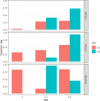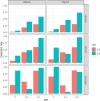How do manipulation checks interfere with the inference of causal relationships?
- PMID: 39739257
- PMCID: PMC11685263
- DOI: 10.3758/s13428-024-02573-3
How do manipulation checks interfere with the inference of causal relationships?
Abstract
This study investigates the performance of mediation analyses, including manipulation check variables, in experimental studies where manipulated psychological attributes are independent variables. We simulated the level of manipulation intensities and measurement errors of the manipulation check variable to test the validity of the analytic practice. Our results showed that when manipulation is successful and measurement error is low, mediation analyses with the manipulation check variable revealed an unstable path coefficient and standard error. Moreover, many of the detected indirect effects were inconsistent mediation situations. However, when individual differences in psychological attributes remained within the condition (low manipulation intensity) and the manipulation check variable contained low measurement error, the indirect effect indicated the validity of the manipulation. We discuss the implications of our findings for the use of manipulation checks in experimental research.
Keywords: Manipulation check; Manipulation intensity; Measurement error; Mediation analysis; Multicollinearity.
© 2024. The Author(s).
Conflict of interest statement
Declarations. Conflicts of interest/Competing interests: The authors declare no competing interests. Ethics approval: Not applicable. Consent to participate: Not applicable. Consent for publication: Not applicable.
Figures






Similar articles
-
Causal Mediation Analysis in Single Case Experimental Designs: Introduction to the Special Issue.Eval Health Prof. 2022 Mar;45(1):3-7. doi: 10.1177/01632787211073194. Epub 2022 Feb 3. Eval Health Prof. 2022. PMID: 35112918 Free PMC article.
-
Mediation Analysis With Exposure-Mediator Interaction and Covariate Measurement Error Under the Additive Hazards Model.Biom J. 2025 Feb;67(1):e70035. doi: 10.1002/bimj.70035. Biom J. 2025. PMID: 39917840
-
Are Manipulation Checks Necessary?Front Psychol. 2018 Jun 21;9:998. doi: 10.3389/fpsyg.2018.00998. eCollection 2018. Front Psychol. 2018. PMID: 29977213 Free PMC article. Review.
-
Statistical Mediation Analysis for Models with a Binary Mediator and a Binary Outcome: the Differences Between Causal and Traditional Mediation Analysis.Prev Sci. 2023 Apr;24(3):408-418. doi: 10.1007/s11121-021-01308-6. Epub 2021 Nov 16. Prev Sci. 2023. PMID: 34782926 Free PMC article.
-
Mediation analysis methods used in observational research: a scoping review and recommendations.BMC Med Res Methodol. 2021 Oct 25;21(1):226. doi: 10.1186/s12874-021-01426-3. BMC Med Res Methodol. 2021. PMID: 34689754 Free PMC article.
References
-
- Alin, A. (2010). Multicolliearity. WIREs. Computational Statistics,2(3), 370–374. 10.1002/wics.84
-
- Aronson, E., & Carlsmith, J. M. (1968). Experimentation in social psychology. In D. T. Gilbert, S. T. Fiske, & G. Lindzey (Eds.), The handbook of social psychology, 2(2), 1–79.
-
- Baron, R. M., & Kenny, D. A. (1986). The moderator-mediator variable distinction in social psychological research: Conceptual, strategic and statistical considerations. Journal of Personality and Social Psychology,51, 1173–1182. 10.1037/0022-3514.51.6.1173 - PubMed
-
- Campbell, D. T., & Cook, T. D. (1979). Quasi-experimentation. Rand Mc-Nally.
-
- Carlsmith, J. M., Ellswarth, P. C., & Aronson, E. (1976). Methods of research in social psychology. Addison-Wesley Publishing Company.
Publication types
MeSH terms
LinkOut - more resources
Full Text Sources

